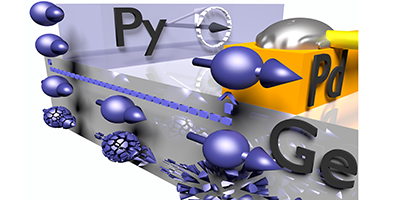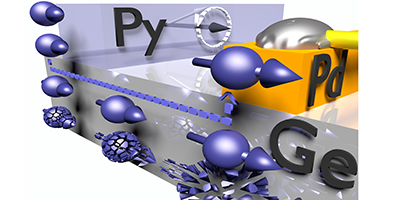Spin Transport in Room-Temperature Germanium
Finding materials that can sustain a spin-polarized current is key for further developing the field of spintronics. Germanium is a promising material because it has a higher carrier mobility than silicon, which could allow for faster devices, but spin transport in germanium has so far only been clearly demonstrated at low temperature (below ). A new room-temperature experiment shows that spin currents can travel more than half a micrometer along a thin slab of doped germanium.
Spintronics—in which electron spin is used to carry information—could revolutionize the electronics industry by increasing computation speed and lowering power consumption. But in most materials, scattering and fluctuating magnetic fields can rapidly flip spins, causing the loss of spin polarization and the associated information. Germanium has a particular lattice symmetry that should reduce much of this spin relaxation. However, since germanium is nonmagnetic, measuring spin transport is not easy because spin currents have to be created in a magnetic material and injected into germanium.
Masashi Shiraishi of Kyoto University, Japan, and his colleagues previously developed a method for studying room-temperature spin transport in semiconductors. They now apply the method to a germanium layer highly doped with an electron donor (phosphorous) and grown on a silicon substrate. On one side of the layer, a ferromagnetic strip, excited by microwaves, injected a spin current into the germanium. This current diffused towards a metallic strip on the opposite side, where it was measured by a detector sensitive to spin-polarization. The team derived a room-temperature spin diffusion length of 660 nanometers—a value comparable to other spin-transport materials—suggesting that germanium could be a potential building block for spin-based transistors.
This research is published in Physical Review Letters.
–Michael Schirber





